Create Campaigns
Learning Objectives
After completing this unit, you’ll be able to:
- Describe how to apply qualifiers to a campaign.
- Explain how you can manage campaigns to save time.
- List four troubleshooting questions.
- Explain how to deactivate qualifiers.
Introduction
Brandon Wilson is ready to build his Spring campaign with the qualifiers and promotions he just created.
Here are his qualifiers.
-
Coupon: spring-code
-
Customer group: loyalty-shoppers and lapsed-shoppers
-
Source Code group: sourcecode-spring
Here are his promotions.
-
Product:
- 20off-brandxsuperspeed
- freebaseballwithbaseballshoes
- buyonegetonehalfoff-brand-y
-
Order: 15%off-ordersover$50
-
Shipping: freeship-ordersover100
Brandon learns that a campaign start date and time and end date and time are optional. If there’s no start date, Salesforce B2C Commerce enables the campaign immediately. If there’s no end date, the campaign runs indefinitely. He wants to run his Spring campaign from January 15 to April 15.
And now he’s ready to create it!
Create a Campaign with Qualifiers and Promotions
Brandon is thrilled with his company’s fabulous new products and wants lots of people to wear them this spring.
Here’s how he creates his campaign.
- In Business Manager, click App Launcher, and select Merchant Tools | Online Marketing | Campaigns.
- Click New.
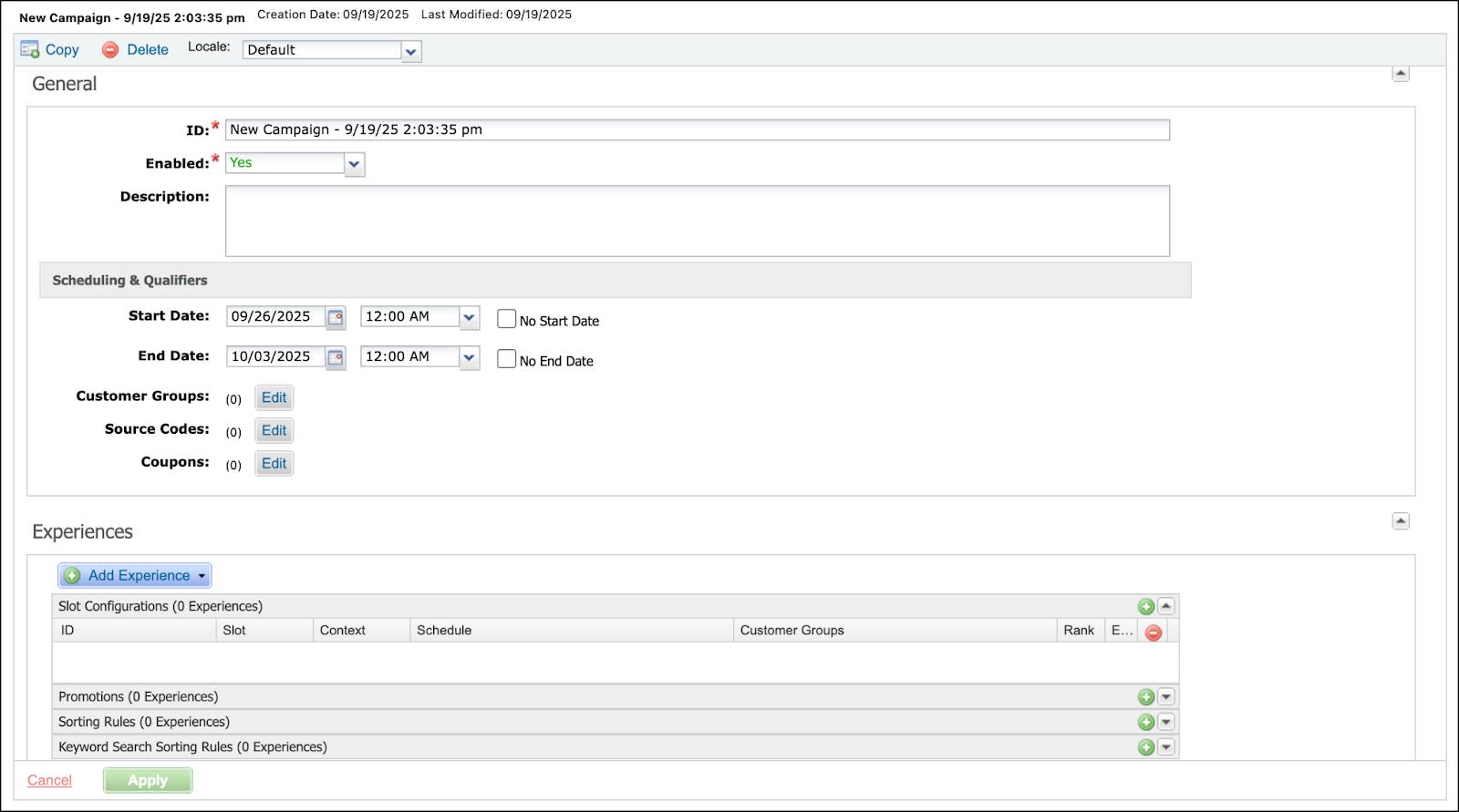
- Enter the values for ID (spring-campaign) and description.
- Select Yes to enable (activate) the campaign.
- Schedule the active dates of the campaign: January 15 to April 15.
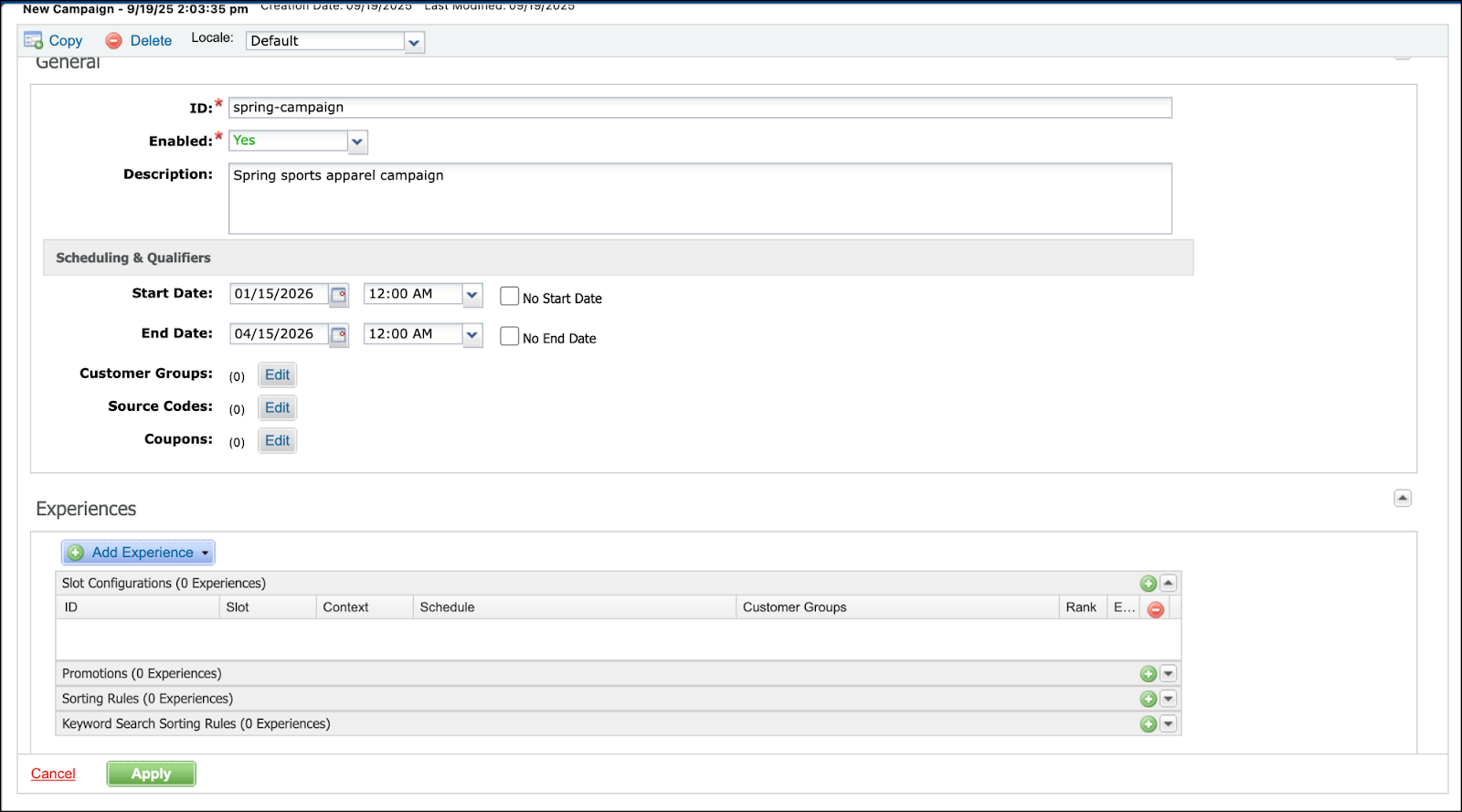
He adds qualifiers.
- Click Edit next to Customer Groups.
- Select lapsed-shoppers and loyalty-shoppers.
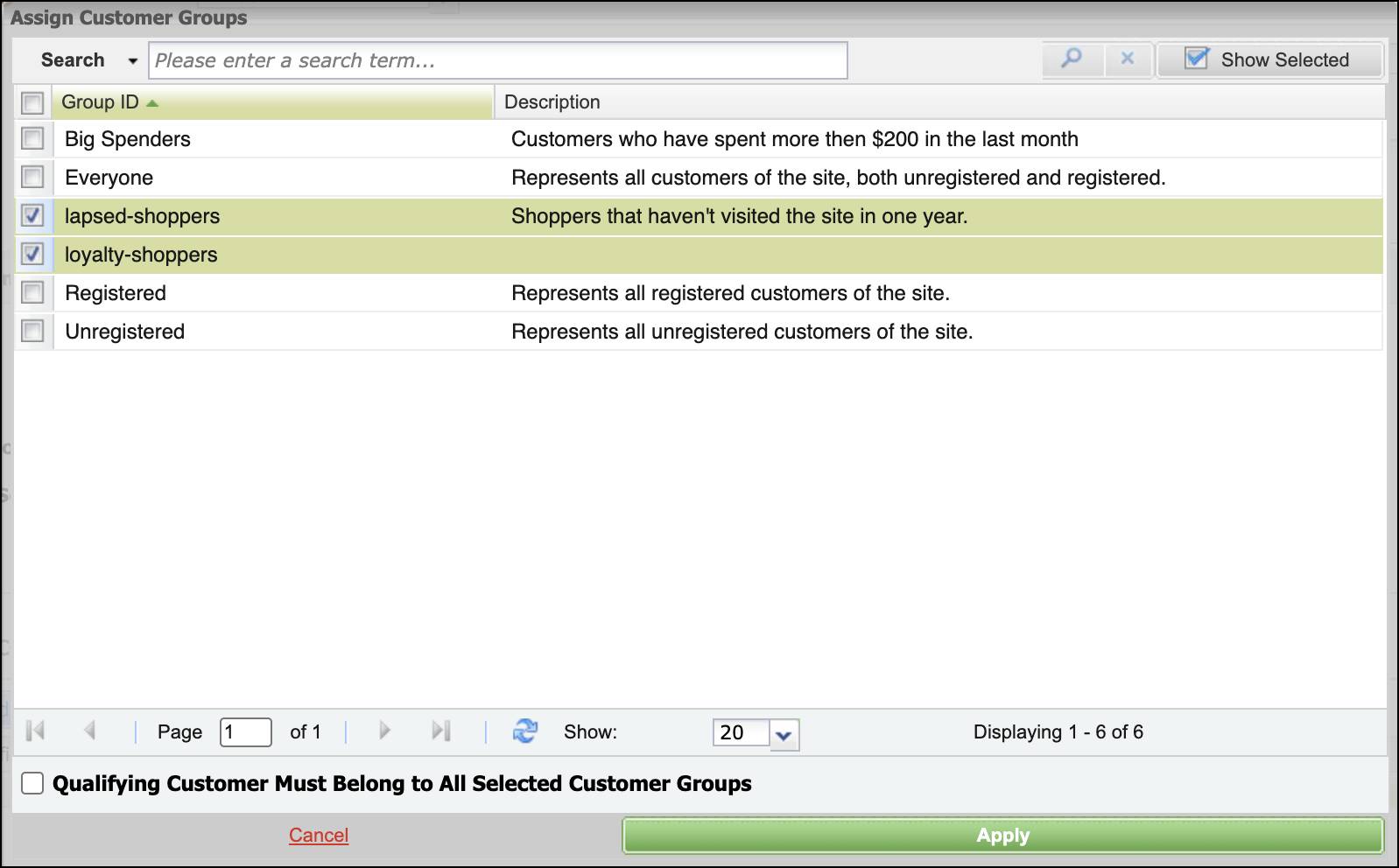
- Don’t select Qualifying Customers Must Belong to All Selected Customer Groups. Brandon wants to be sure that both lapsed-shoppers and loyalty-shoppers can qualify. A shopper must meet one of the two eligibility criteria, not both.
- Click Apply.
- Click Edit next to Source Codes.
- Select sourcecode-spring.
[Alt text: In Business Manager, assign the source code sourcecode-spring.]
- Click Apply.
- On the campaign details page, click Edit beside Coupons.
- Select spring-codes.
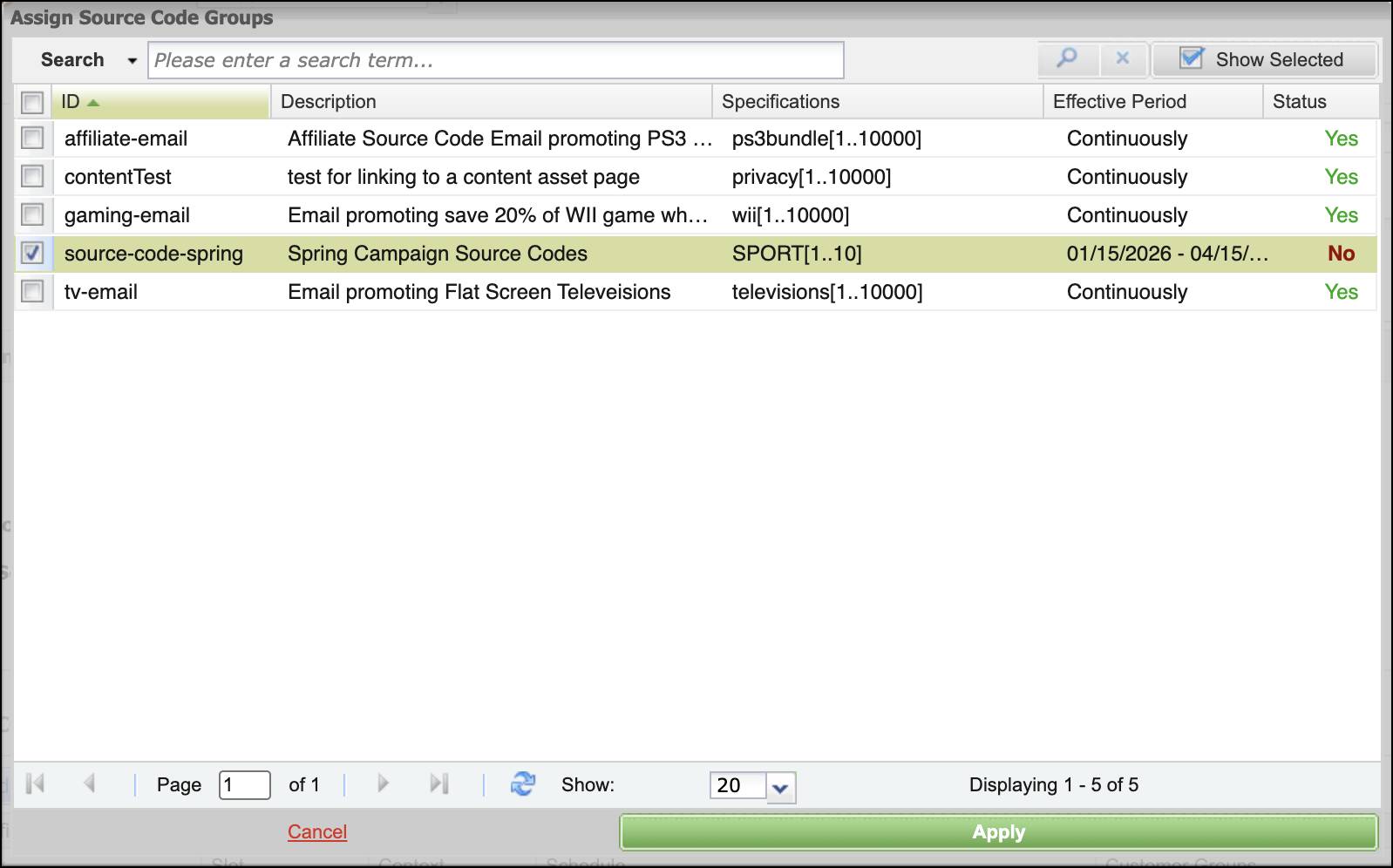
- Click Apply.
He adds experiences.
- Click Add Experience and select Add Promotion.
- Click the Enabled tab twice to show the enabled promotions at the top. You can also search for them.
- Select the promotions that you created.
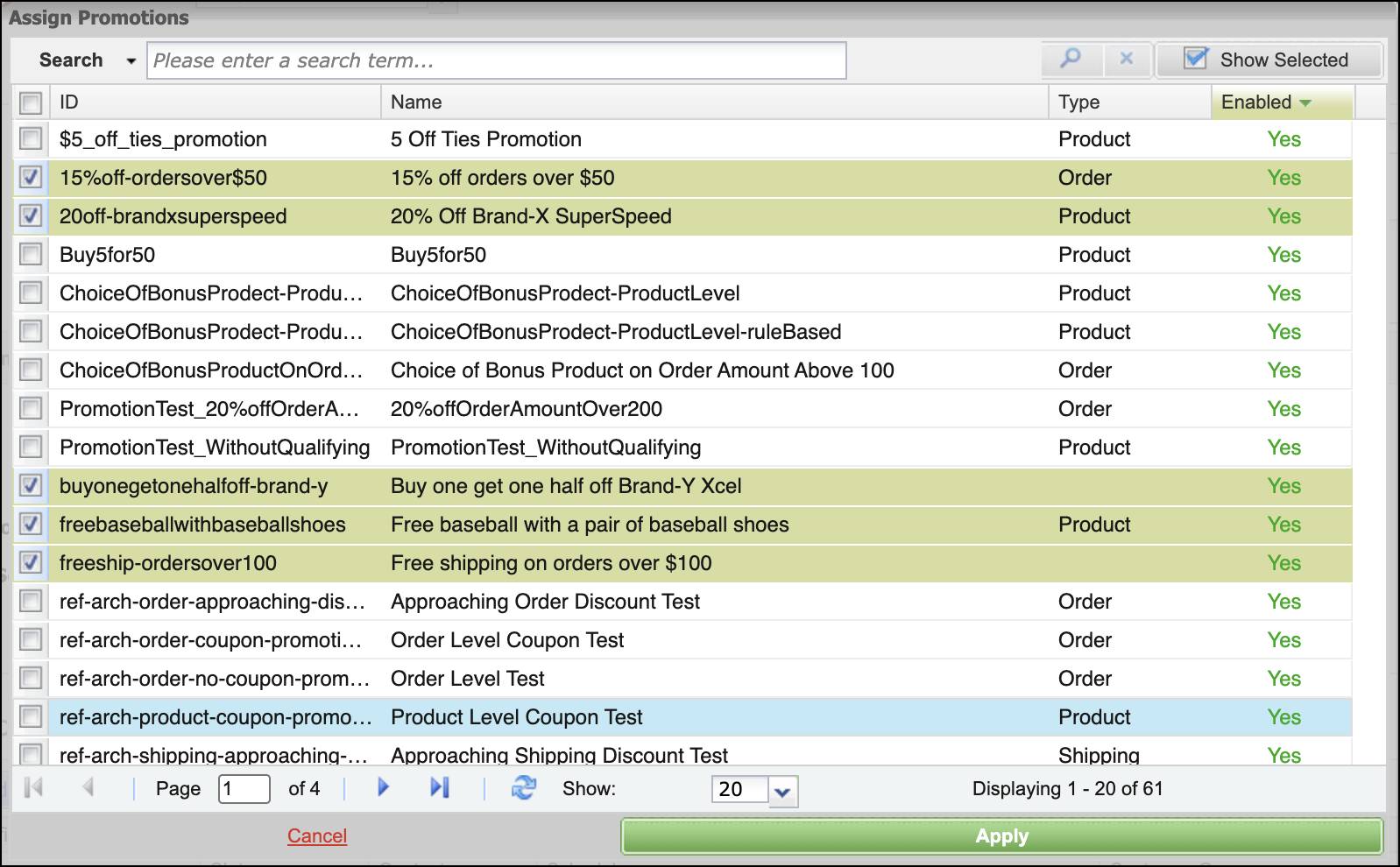
- Click Apply.
Which Qualifiers?
Remember, Brandon wants certain promotions to use certain qualifiers. Currently, all the qualifiers apply to all the promotions.
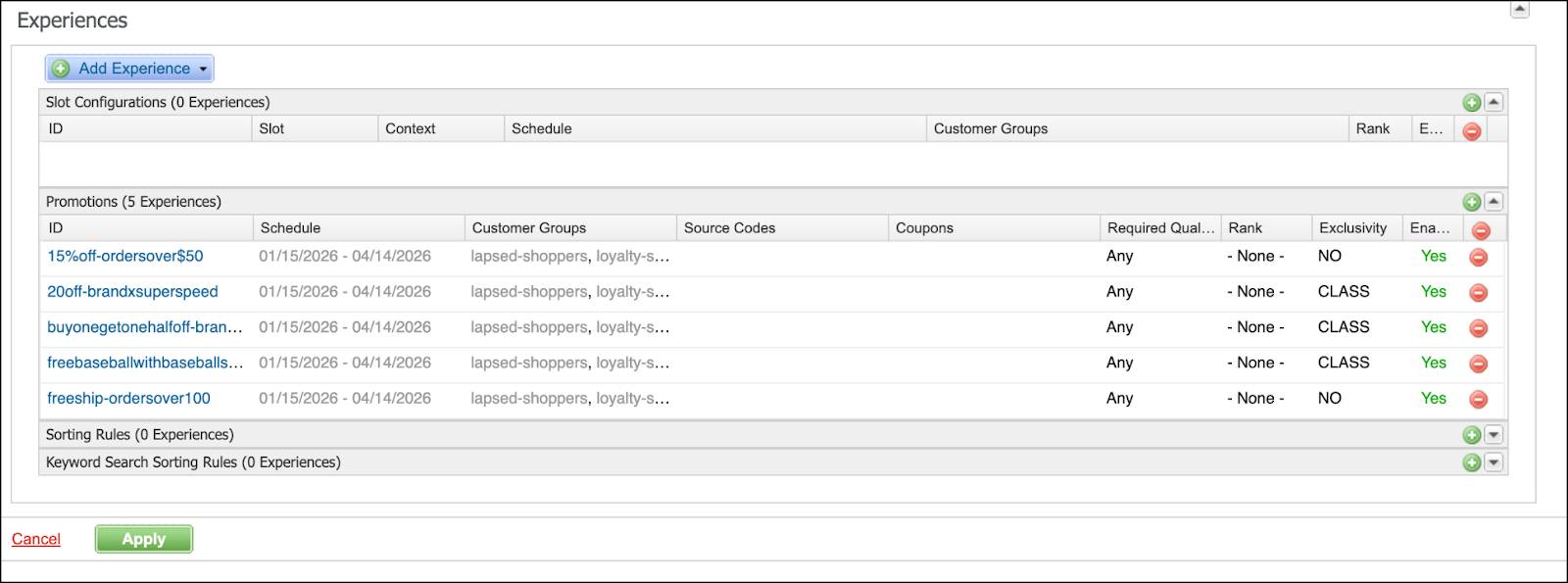
He can deactivate qualifiers that don’t apply. So he reviews his campaign plan to see what he needs to do.
Discount |
Qualifier |
Qualifier Type |
|
|---|---|---|---|
20% off Brand-X SuperSpeed running shoes |
% off |
Coupon |
Single Coupon |
20% off Brand-X SuperSpeed running shoes |
% off |
Customer Group |
Static - loyalty-shoppers |
Free baseball with baseball shoes |
Bonus |
Coupon |
Multiple codes |
15% off orders over US$50 |
% off |
Coupon |
Dynamic - lapsed-shoppers |
Buy one get one half off Brand-Y Xcel athletic shorts and t-shirts |
% off |
Customer Group |
Dynamic - lapsed-shoppers |
Free shipping on orders over $100 |
Free Shipping |
Source Code |
Here’s how he deselects qualifiers that don’t apply.
- Open the campaign.
- Expand the Promotions experiences.
- Click the … beside a qualifier you want to deselect.
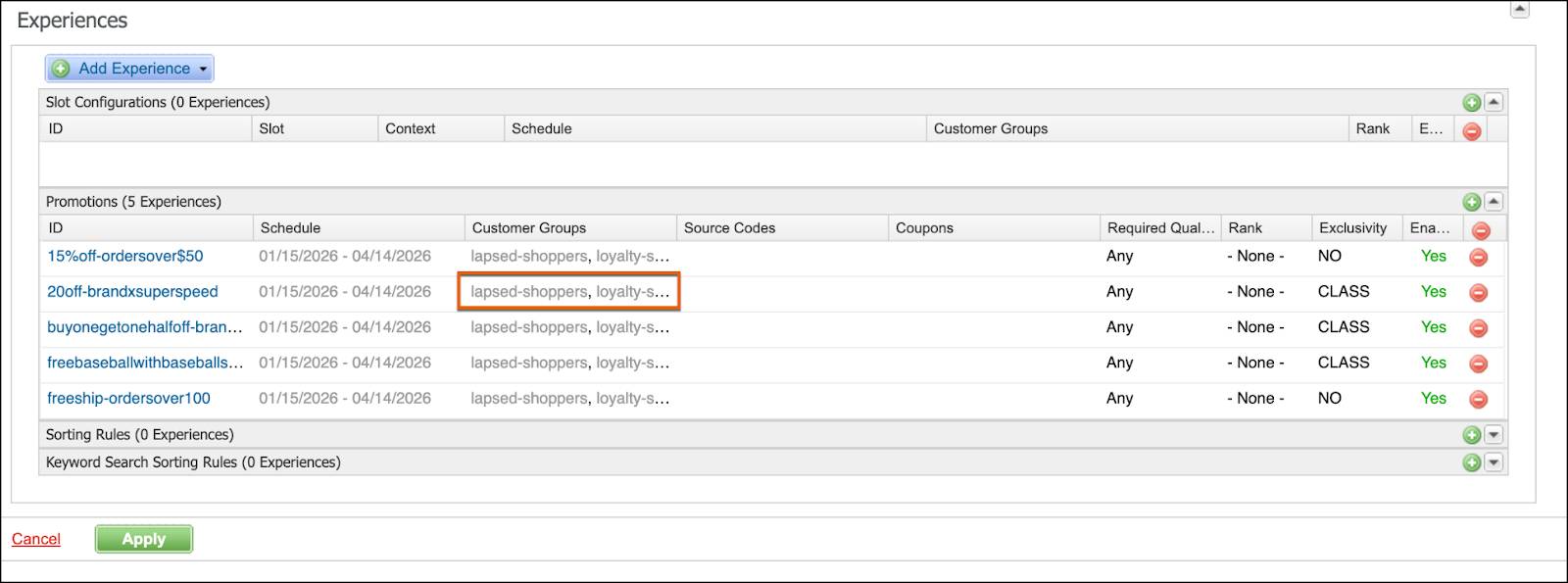
- Deselect Use Customer Groups as Promotion Qualifiers?
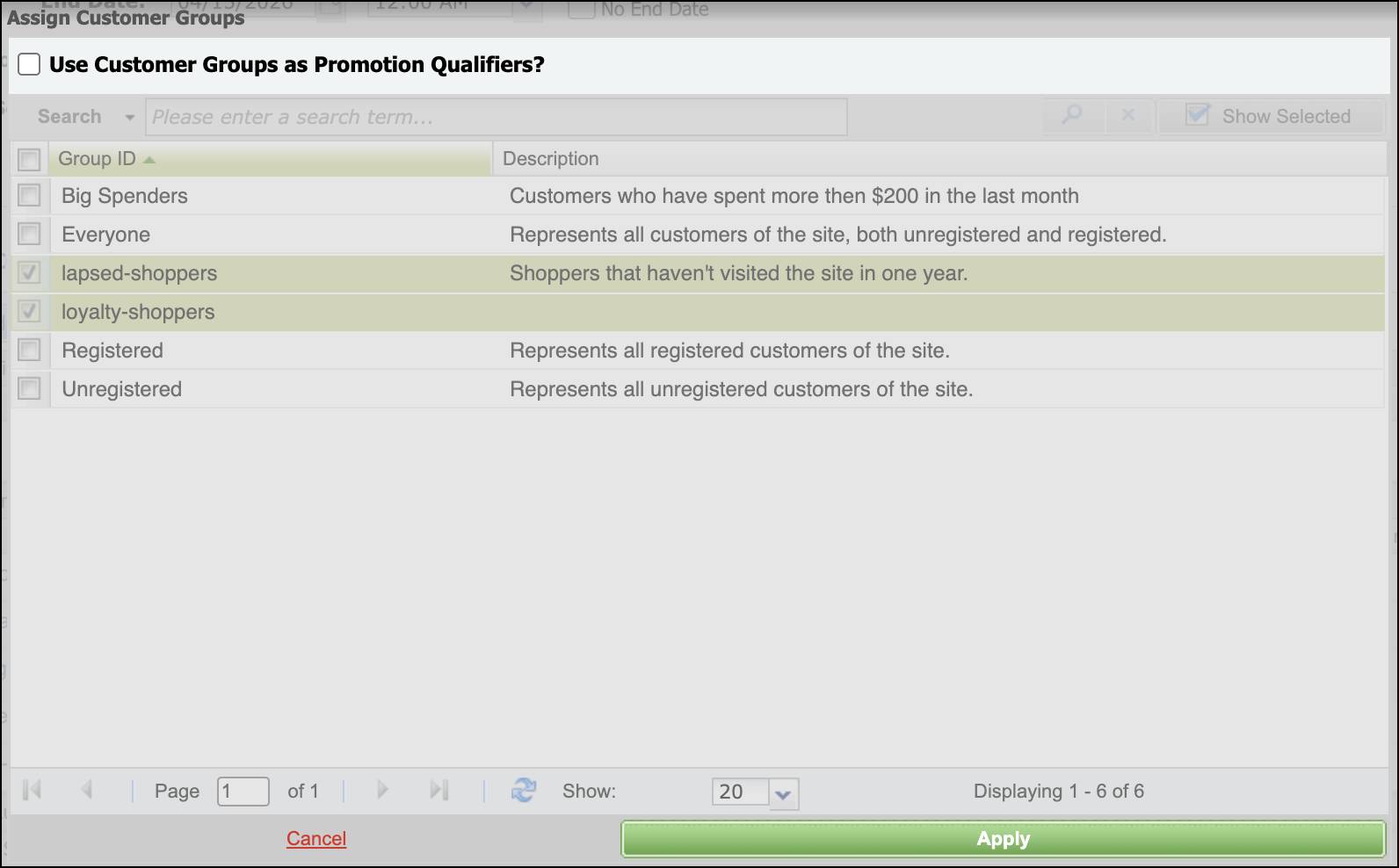
- Click Apply.
- Click Apply on the Campaign page as well.
Brandon can specify if Any or All qualifiers apply in the Required Qualifiers field.
- Any means that if a shopper meets at least one qualifier, they are eligible for the promotion.
- All means that they must meet all the qualifiers to be eligible.
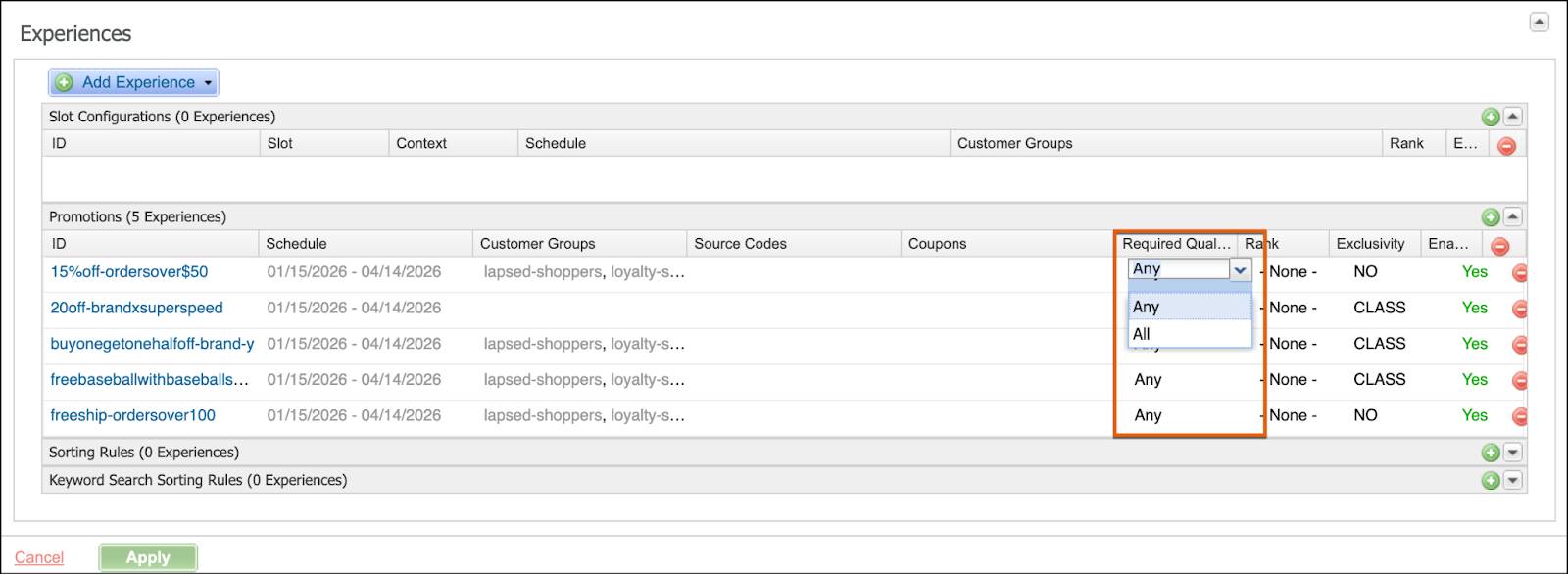
He can configure this for each promotion experience from within a campaign. If he configures a promotion as All, for example, then the shopper must meet ALL eligibility criteria. They must be a logged-in loyalty program member, navigate to the storefront by clicking a source code, and use a coupon code.
Brandon can also apply rank to each promotion in the campaign by clicking in the Rank field (next to the Any and All setting) for each promotion and applying a value.
Create Other Experiences
Brandon focused on promotion experiences in this module, but plans to use slot configuration and sorting rule experiences once he’s tested his promotions.
For slot configurations, he can modify the overall campaign schedule and assign more customer groups and a rank. Here, he can select the slot configurations he wants to use.
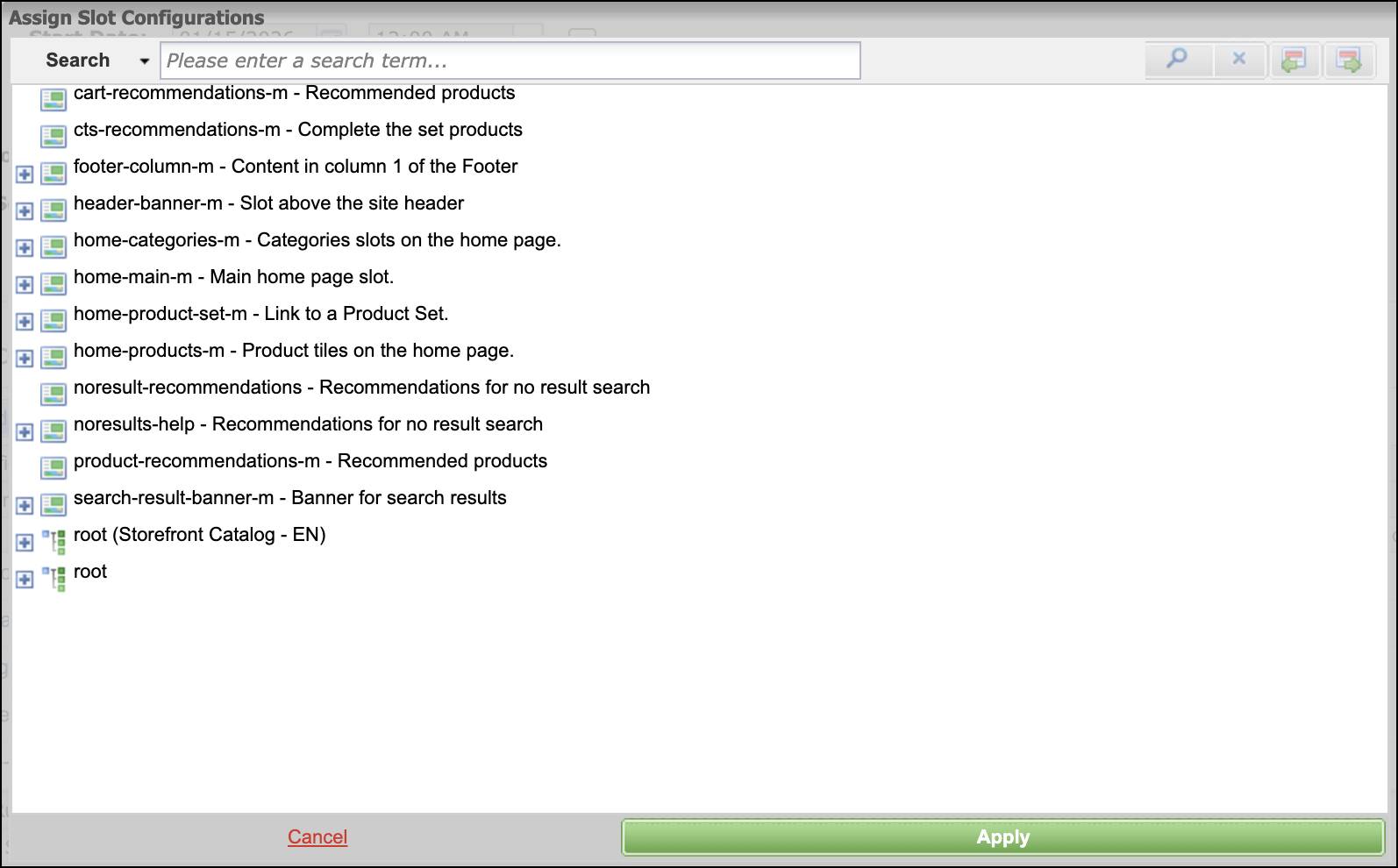
For a sorting rule experience, he can select one or more sorting rules. Here, he selects the brand sorting rule.

Within a campaign, he can specify one or more categories or subcategories for each sorting rule experience.
Manage Campaigns
Once Brandon creates his first campaign, he can use it as a default campaign, which will save him a lot of time in the future. He can copy the existing campaign when he only needs to make minor changes for a new one.
Test Experiences
Brandon wants to see the effect of his campaign in the storefront. He starts by testing the order promotion: 15%off-ordersover$50
Here’s what he does.
- Open Business Manager.
- Select the site: CloudKicks
- Click the Storefront tab. The storefront opens in a new browser window.
- On the storefront, search for products and add them to the cart.
- Click the Cart icon.
- Yay! His discount callout message displays beneath the product list and above the coupon entry fields.
If he doesn’t see his promotion, it’s time to troubleshoot. Otherwise, he moves on to test his other promotions.
Troubleshoot
When Brandon’s experiences don’t work as he expects, here’s what he checks.
- The promotion exists in a campaign.
- The campaign that the promotion belongs to is enabled and valid for the current date.
- The promotion is enabled and valid for the current date.
- Shoppers qualify for a promotion by various criteria, for example:
- Being a member of one of the target customer groups
- OR providing a valid coupon associated with the promotion
- OR providing a valid source code associated with the promotion
- AND that source code is assigned to the promotion and is enabled
- If the Any/All selection makes sense. A promotion might not work because it requires All eligibility criteria and the shopper meets only some of the criteria. When this happens, it's an opportunity to re-evaluate whether you want to require All.
- If it's a product promotion, you:
- Selected products that match the qualifying products rules, in the appropriate quantity or amount (if applicable).
- Selected products that are eligible for the discount (if applicable).
- If it's an order promotion, you have merchandise in your cart that exceeds the merchandise threshold specified after product discounts are applied. Gift certificates don’t count towards the merchandise total.
- If it's a shipping promotion, you have:
- Merchandise in your cart that exceeds the merchandise threshold specified after product and order level discounts have been applied. Gift certificates don't count towards the merchandise total.
- Provided location information so B2C Commerce can calculate shipping.
- Selected a shipping method that’s eligible for the discount.
Storefront Toolkit
Brandon can use the Storefront Toolkit to test and troubleshoot campaigns on a staging instance. The staging instance is where he brings the application and data together before deploying to a production instance.
Here are the steps he takes.
- In Business Manager, click App Launcher, and select Merchant Tools | SitePreferences | Toolkit.
- In the storefront, click the Toolkit icon in the upper left corner. If you use the Toolkit Beta, the tools are in the upper right corner of the storefront, as shown here.

- Click Preview Settings.
- Set a date and time for the storefront and view the storefront. He can check that his promotions work within the right time periods.
- Specify a customer group or source code and see how the storefront looks when logged in as a customer of the group or a customer using the code.
Let's Sum It Up
In this unit, you followed along with Brandon Wilson as he created a campaign using the qualifiers and promotions he configured in previous units. You also learned how to manage, view, and troubleshoot campaigns.
Now that you’ve learned all about qualifiers, promotions, and campaigns, promote yourself by taking the last quiz and earn a cool new badge!
Resources
